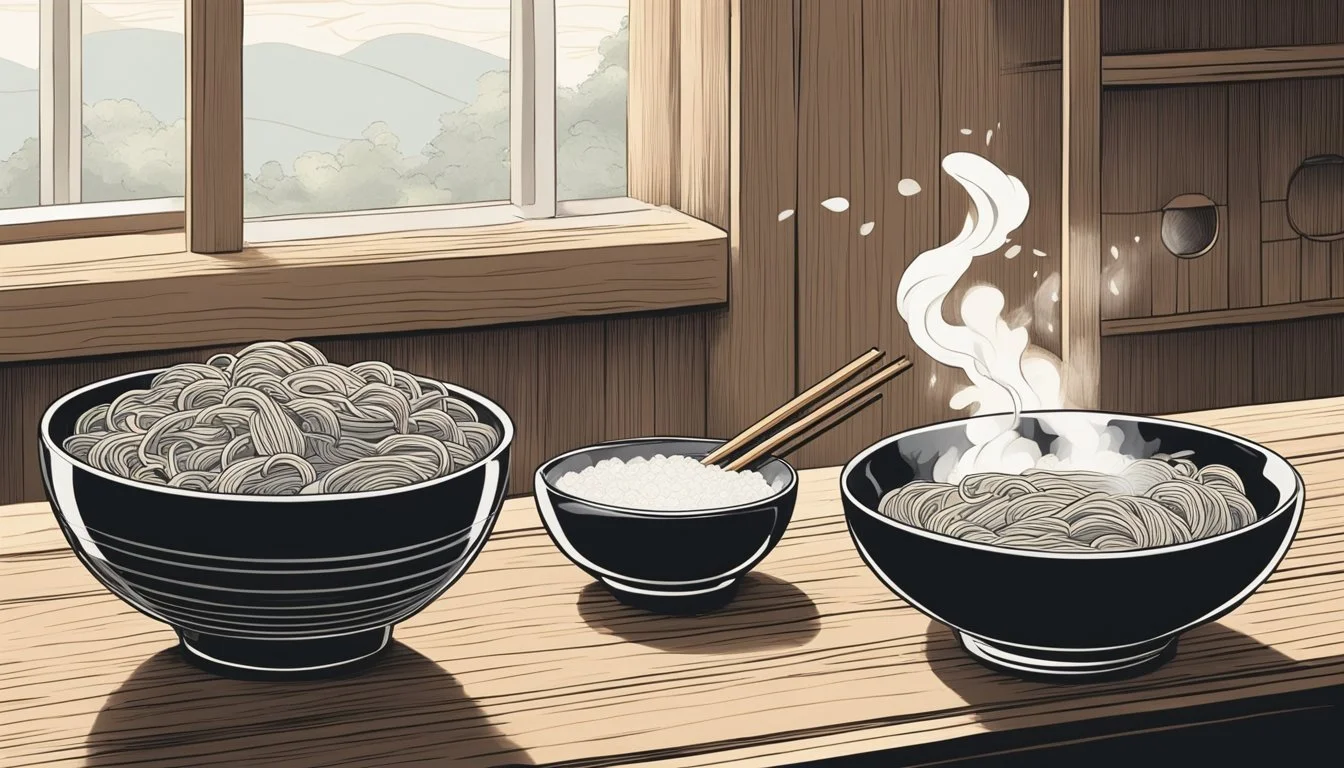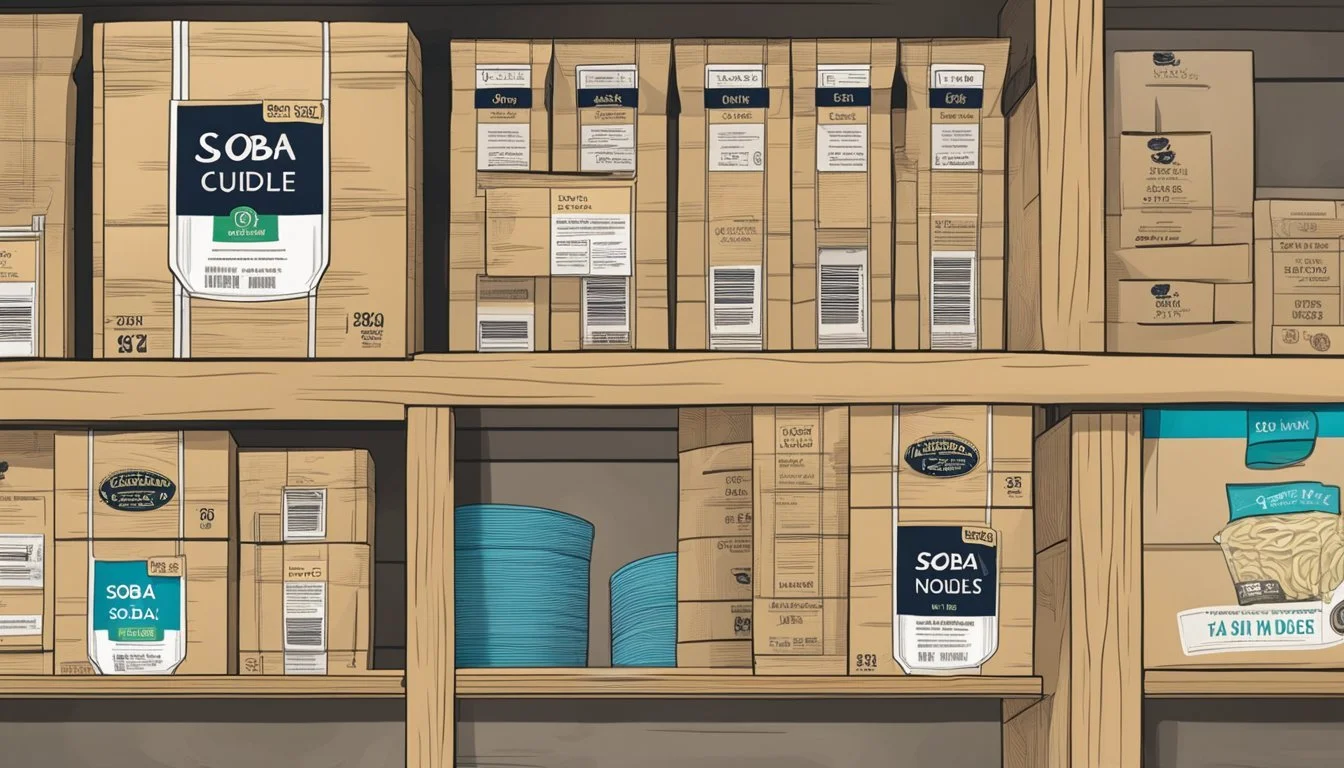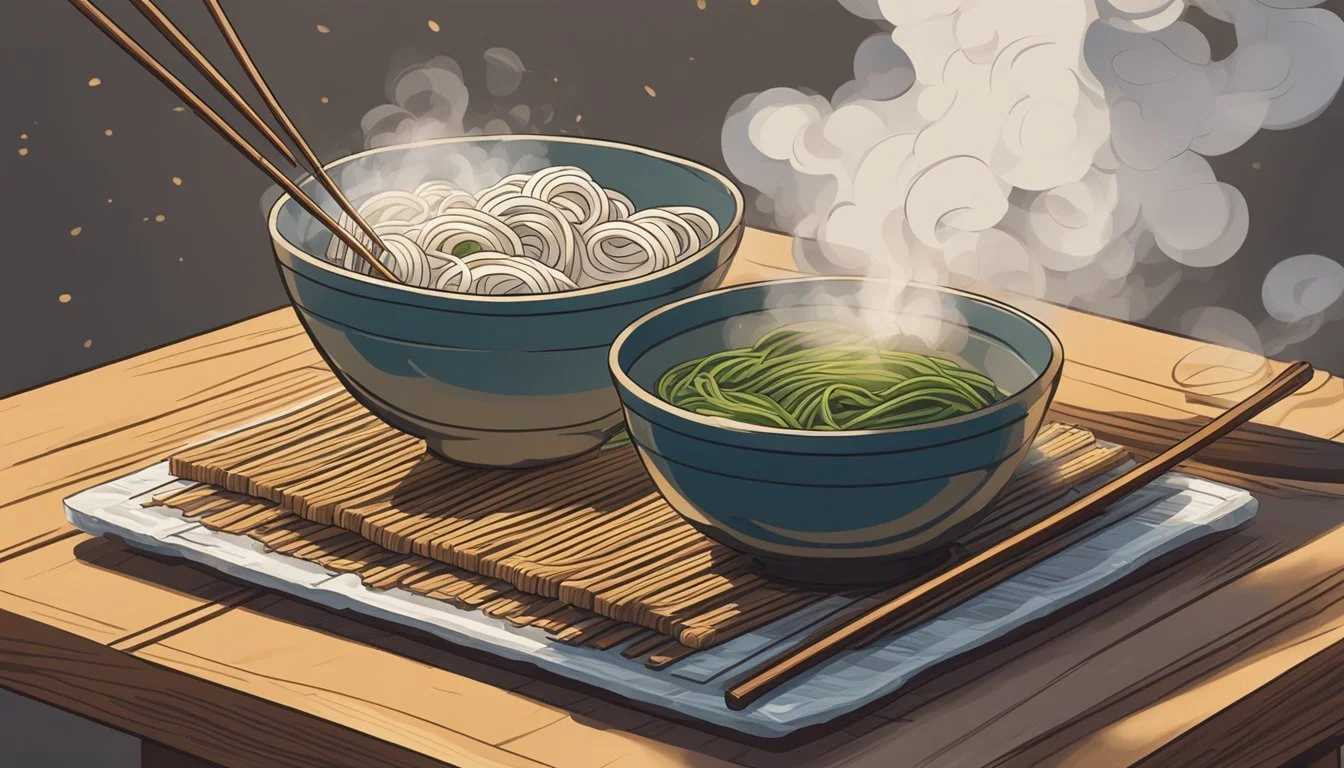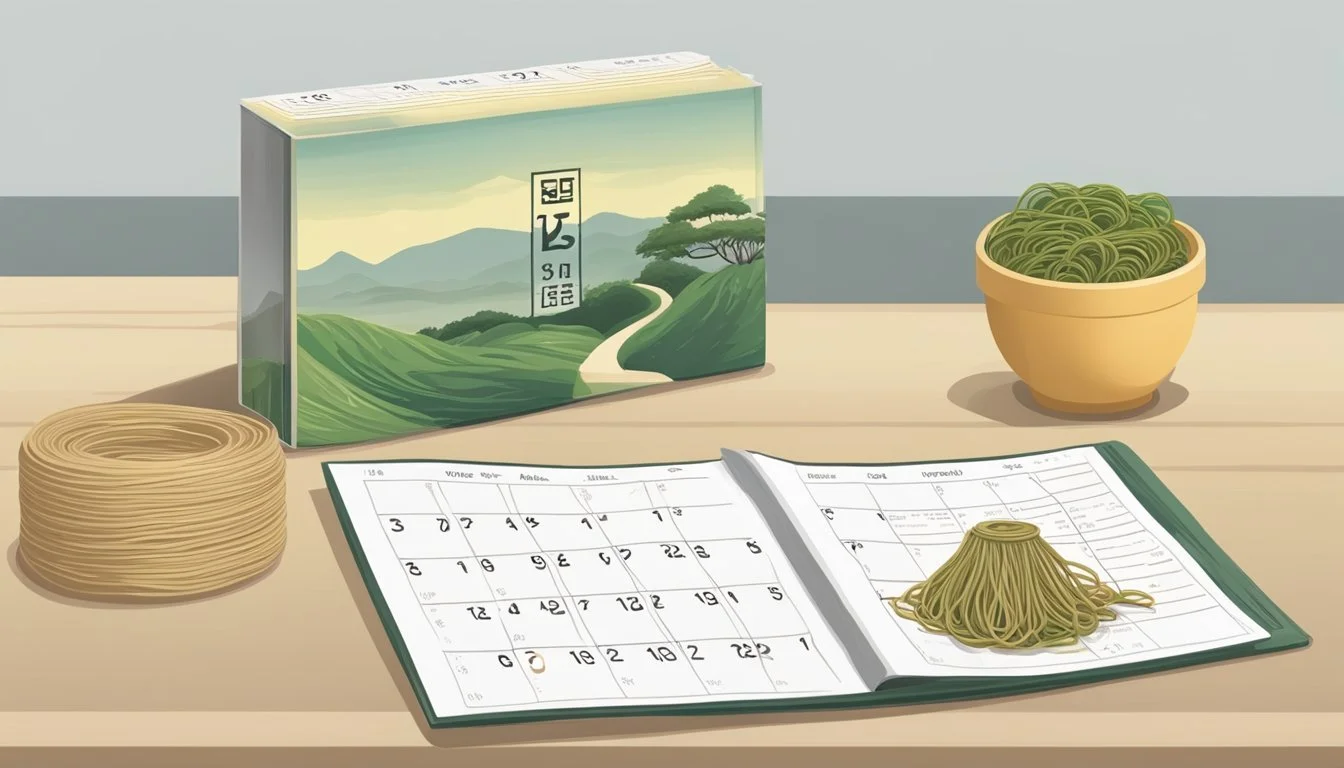How Long Do Soba Noodles Last?
Shelf Life and Storage Tips
Soba noodles (how long do soba noodles last?), a staple of Japanese cuisine, are distinguished by their primary ingredient, buckwheat. Their nutty flavor and firm texture make them popular around the world. These versatile noodles differ from Italian pasta not just in flavor but also in the way they are stored and preserved. When uncooked and kept dry, soba noodles can have a substantial shelf life, lasting for months in the pantry because of their low moisture content and robust nature.
While the longevity of dry soba noodles is impressive, once they are cooked, the storage dynamics change considerably. Cooked soba noodles require proper handling to maintain their freshness and quality. The key lies in cooling them down immediately after cooking, which typically involves rinsing under cold water to halt the cooking process and remove excess starch. This technique is crucial for preventing the noodles from clumping together or becoming overly soft.
Ensuring soba noodles retain their optimal state involves a combination of correct cooking, prompt cooling, and suitable storage conditions. Whether they are being stored dry in the pantry, cooked in the refrigerator, or frozen for long-term use, knowing the proper techniques will help maintain their desired taste and texture, ready for inclusion in a variety of dishes.
Soba Noodles Overview
Soba noodles are a type of Japanese noodle renowned for their distinctive taste and health benefits. They are commonly made from buckwheat flour (how long does buckwheat flour last?), providing a gluten-free option for various diets.
Ingredients and Types
Soba noodles primarily consist of buckwheat flour, which gives them their unique flavor and texture. This pseudo grain is not related to wheat but to rhubarb and sorrel. The ingredients often include a combination of:
Buckwheat flour: The core component providing flavor and health qualities.
Wheat flour: Sometimes added to improve the texture and elasticity of the noodles.
There are different types of soba noodles depending on the percentage of buckwheat flour to wheat flour, ranging from juwari soba (100% buckwheat) to ni-hachi soba (80% buckwheat, 20% wheat flour). These variations can affect both flavor and nutritional value, as well as whether the noodles are gluten-free.
Nutritional Value
Soba noodles are often considered a healthy choice due to their nutritional profile:
High in complex carbohydrates: They offer longer-lasting energy compared to refined grains.
Protein content: Buckwheat provides a good amount of plant-based protein.
Gluten-free: Pure buckwheat soba noodles are suitable for gluten-free diets.
The table below outlines the key nutritional components of buckwheat-based soba noodles (per 100g):
Nutrient Amount Calories ~343 Protein ~13.3g Carbohydrates ~71.5g Fibre ~10g Fat ~3.4g
It's important to check the label for specific nutritional information, as these values can vary depending on the brand and recipe used.
Preparation and Cooking Methods
Properly preparing and cooking soba noodles is crucial for achieving the right texture and flavor. They require a balance of boiling and rinsing, and varying methods can be incorporated into dishes, whether traditional or fusion.
Boiling and Rinsing
To cook soba noodles, one should start with a pot of boiling water. A general guideline is to use about 4 cups of water for every 100 grams of noodles. Place the noodles gently in the pot, ensuring there is enough room for them to swirl around. The cooking time is typically between 5-7 minutes; however, this can vary slightly depending on the specific noodles used.
Immediately after cooking, it's imperative to drain and rinse the noodles under cold water. This stops the cooking process and removes excess starch, which prevents the noodles from becoming gummy. Use your hands to separate the noodles while rinsing to ensure they don't stick together.
Incorporating Into Dishes
Soba noodles can be versatile in a variety of recipes. They can be served chilled with a dipping sauce or in a salad, or they can be included in a hot stir-fry dish. For a departure from traditional uses, soba can be substituted for Italian pasta in many recipes. Regardless of how they are served, care must be taken not to overcook the noodles to maintain their texture and integrity.
Here are the key steps for each preparation method:
Boiling:
Bring a large pot of water to a boil.
Add soba noodles and gently stir to prevent sticking.
Cook for 5-7 minutes, or according to package cooking instructions.
Rinsing:
Drain cooked noodles in a colander.
Rinse immediately with cold water to cool.
Use hands to separate noodles as they are being rinsed.
Incorporation into dishes varies based on the recipe but generally follows these guidelines:
For cold dishes:
Toss rinsed noodles with dressings or sauces and serve.
For hot dishes:
Add to stir-fry or other recipes, heating just until warm throughout.
When handling soba noodles, a gentle and attentive approach during the cooking process ensures they retain their unique texture and flavor, making them a delightful component in an array of dishes.
Storing Soba Noodles
Storing soba noodles correctly ensures their quality and extends their shelf life. Whether kept in the pantry, refrigerated, or frozen, using airtight containers is key.
Pantry Storage
Dry soba noodles, thanks to their mostly buckwheat base, are well-suited for pantry storage. Shelf life in the pantry is typically several months if they remain unopened in their original packaging. They should be kept in a cool, dry place, away from direct sunlight and moisture to maintain their quality.
Refrigeration and Freezing
Once cooked, soba noodles can be refrigerated for up to three to five days. For extended shelf life, they can be frozen where they will remain good for about two weeks. It is important to cool the noodles completely and drain any excess water before storing to prevent sogginess.
Airtight Containers
Whether storing soba noodles in the pantry, refrigerator, or freezer, airtight containers or sealable bags are essential. They prevent the noodles from absorbing odors and moisture that can ruin their texture and freshness. Properly sealed, the noodles are protected from spoilage and staleness.
Shelf Life and Spoilage
When it comes to soba noodles, their shelf life can vary significantly between uncooked dry soba and cooked soba noodles. Proper storage is essential to prevent spoilage and maintain freshness.
Uncooked Soba
Dry uncooked soba noodles typically have a long shelf life when stored at room temperature. The key factors affecting their longevity include the packaging, moisture levels, and storage location.
Packaging: Sealed packaging helps prevent exposure to moisture and pests.
Moisture levels: Low humidity is crucial to avoid spoilage and extend shelf life.
Storage location: A cool, dry pantry can keep uncooked soba fresh for several months, sometimes even up to a year.
Cooked Soba and Leftovers
In contrast, cooked soba noodles are more perishable:
Refrigerator Storage: They should be stored in an airtight container in the refrigerator to slow down bacterial growth.
Shelf Life: Typically, cooked soba can last for 3-5 days in the refrigerator before freshness begins to decline.
Spoilage Indicators: Signs such as a sour smell, a slimy texture, or any visible mold suggest that the noodles should be discarded.
To maximize the shelf life of soba noodles, whether dry or cooked, one must be vigilant against factors that can accelerate spoilage, such as excess moisture and temperature fluctuations.
Reheating and Serving Suggestions
When it comes to soba noodles, reheating should preserve their texture and flavor. The noodles can be enjoyed as a warm stir fry, a hot side dish, or a cold noodle salad. The following methods ensure that soba noodles are reheated optimally and incorporated into recipes skillfully.
Optimal Reheating Methods
Reheating soba noodles can be done efficiently using a microwave, stovetop, or oven. Here's how to achieve the best results:
Microwave: Place the noodles in a microwave-safe dish, sprinkle with a bit of water to prevent drying out, and cover. Heat on high for 30-60 seconds, stirring halfway through to ensure even warming.
Stovetop: For stir-fry dishes, quickly toss the noodles in a pan over medium heat with a small amount of oil or cooking spray. If serving in a broth, submerge noodles directly into the simmering liquid until warmed through.
Oven: Preheat the oven to 350 degrees Fahrenheit. Spread the noodles out in an even layer on a baking sheet, lightly moisten with water, and cover with aluminum foil. Heat for about 10 minutes or until they reach the desired temperature.
Recipe Ideas
Soba noodles offer versatility whether served hot or cold. Here are a couple of recipe suggestions:
Stir Fry: Toss reheated soba noodles with a mix of vegetables, a protein of choice, and a savory sauce. Serve hot as a main dish, ensuring that the noodles are well-coated and glossy.
Noodle Salad: Mix cold soba noodles with sliced cucumber, carrots, bell peppers, and a tangy dressing. Top with sesame seeds (how long do sesame seeds last?) and fresh herbs for a refreshing side dish or light meal.
By following these suggestions, one can restore the noodles to their best state, preserving their quality whether incorporating them in a hot stir fry or a cool noodle salad.
Health Benefits and Considerations
When considering soba noodles, it’s important to evaluate their nutritional makeup and how they may fit into various dietary needs, such as those seeking protein-rich, gluten-free, or plant-based options.
Dietary Advantages
Soba noodles offer several nutritional benefits for those who include them in their diet. They are often made from buckwheat flour, which provides a good source of protein and fiber. In terms of micronutrients, soba noodles contain manganese, necessary for bone health and glucose metabolism.
Protein: A serving of soba noodles can contain around 5-6 grams of protein, which is vital for muscle repair and building.
Carbohydrates: The carbs in soba are mostly complex, contributing to slow digestion and steady energy.
Fiber: Buckwheat noodles are higher in fiber compared to traditional pasta, aiding in digestive health.
Iron: They also contain iron, which is crucial for transporting oxygen in the blood.
For those following a vegetarian or plant-based diet, soba noodles can be a fitting choice, offering a satisfying base for a variety of dishes while contributing beneficial nutrients.
Allergy Information
Soba noodles are often touted as a gluten-free option; however, one should exercise caution, as not all soba noodles are made purely from buckwheat—some may contain wheat flour. Hence, checking labels is crucial for those with gluten intolerance or celiac disease.
Consumers desiring a strictly gluten-free food should opt for 100% buckwheat soba noodles and verify that they have been processed in a gluten-free facility to avoid cross-contamination. Given that buckwheat is not a grain but a pseudo-grain, it offers a healthful alternative for those unable to consume wheat or looking for variety in their gluten-free diet.
Comparisons and Alternatives
When considering soba noodles in relation to other types of noodles and potential substitutes, the primary differences lie in their composition, shelf life, and culinary use. The nuances of these aspects are key to understanding how soba fares against its counterparts and what alternatives might be appropriate in various dishes.
Soba vs Other Noodles
Soba noodles, crafted predominantly from buckwheat flour, stand out from Italian pasta and ramen with their unique nutty flavor and texture. Unlike the wheat-based Italian pasta, soba noodles generally have a shorter shelf life when cooked, usually lasting up to three days in the refrigerator. Italian pasta can often endure a slightly longer refrigerated period while maintaining quality.
Noodle Type Base Ingredient Shelf Life (Dry) Shelf Life (Cooked) Soba Buckwheat Flour Several Months Up to 3 days Italian Pasta Wheat Flour 1-2 Years 3-5 days Ramen Wheat Flour 2 Months - 1 Year 5-7 days
Ramen noodles (how long do ramen noodles last?), a common staple in Asian cuisine, can either come dried or fresh, typically lasting longer than cooked soba noodles when stored properly in the refrigerator. Both ramen and soba are prominent in stir-fries and soups, with ramen often accompanied by a savory broth and distinct seasoning.
Alternative Ingredients
When soba noodles are unavailable, several alternatives can be used to mimic their role in various dishes:
For stir-fries and noodle bowls, whole-grain pasta is a strong substitute, providing a similar bite and nutritional profile.
Whole wheat vermicelli works well in salads, offering a texture comparable to that of soba noodles.
In a pinch, ramen noodles can be used without their seasoning packets to substitute soba, especially in soups and broths, though they have a slightly different texture and flavor.
It's important to acknowledge that while these substitutes can replace soba noodles in a functional sense, each brings its own taste and qualities to the dish, which may alter the dish's authenticity and character.
Enhancing Flavor and Texture
Maximizing the flavor and texture of soba noodles involves careful selection of sauces and seasonings, choosing the right accompaniments, and steering clear of common cooking pitfalls. Achieving the desired nutty flavor and avoiding a gummy texture are key to exceptional soba dishes.
Sauces and Seasonings
Soba noodles are known for their distinct nutty flavor, which can be enhanced with the right sauces and seasonings. A staple in soba seasoning is soy sauce, providing a salty and umami flavor profile. To elevate the noodles further:
Sesame oil:(how long does sesame oil last?) A small drizzle imparts a rich aroma and complements the inherent nutty notes of soba.
Dipping sauces: They often integrate a balance of soy sauce, mirin, and sometimes dashi broth, enhancing the noodles without overpowering them.
Accompaniments
The right accompaniments not only add to the flavor of soba noodles but also contribute to the overall texture. Properly cooked soba noodles should be al dente to ensure they retain a slightly chewy texture.
Add crisp vegetables for a contrasting texture.
Protein options like tofu or tempura can be combined with soba for a heartier meal, ensuring a diverse texture profile.
Avoiding Common Mistakes
When cooking and serving soba noodles, one must take care to avoid common mistakes that can detract from flavor and texture.
Overcooking: It can lead to a gummy texture, so soba should be monitored to retain its al dente quality.
Clumping: To prevent noodles from sticking together, they should be rinsed under cold water after cooking—this stops the cooking process and removes excess starch.
Always toss the noodles with a bit of oil if they are not to be served immediately, which helps maintain separation.










